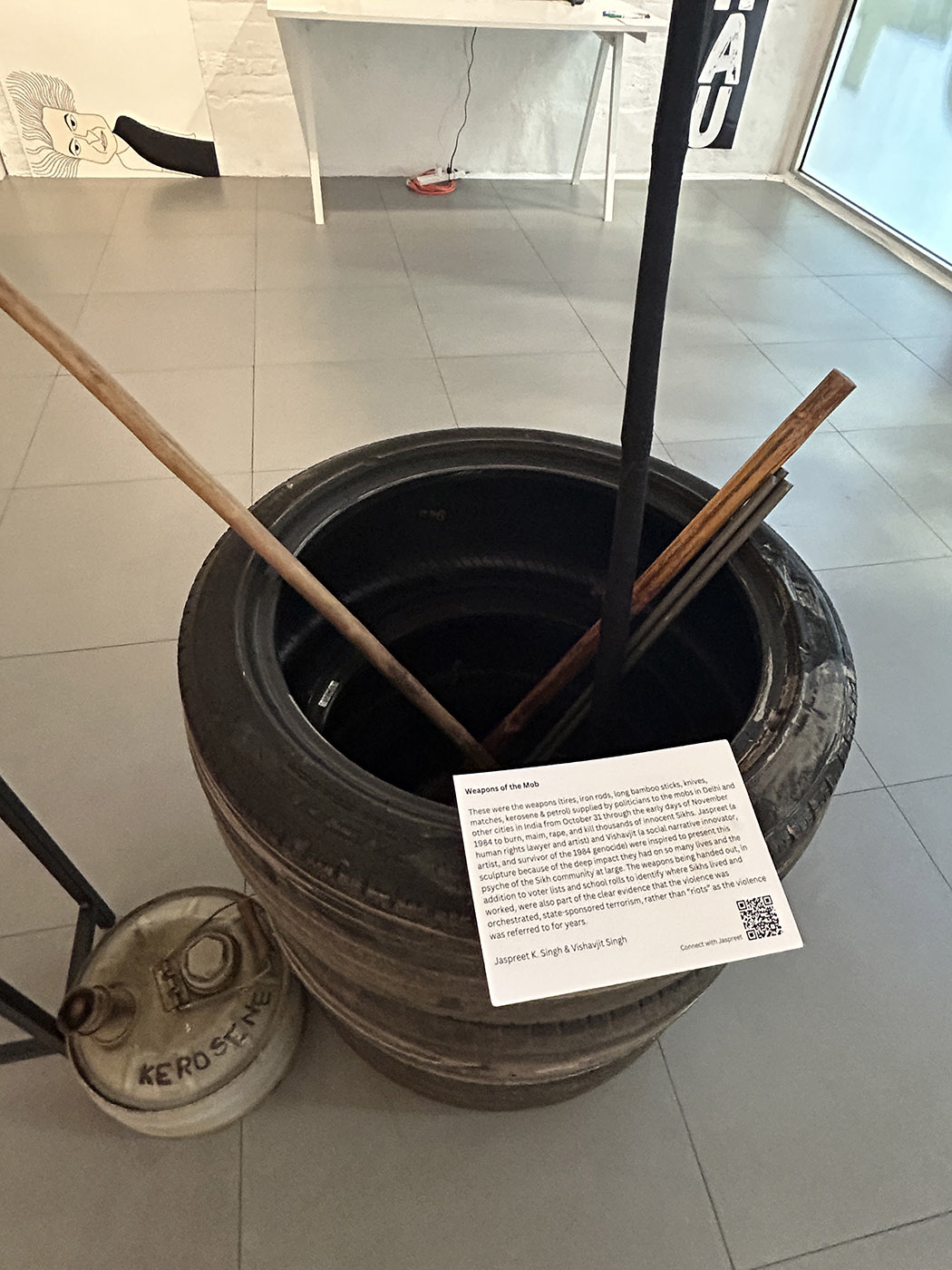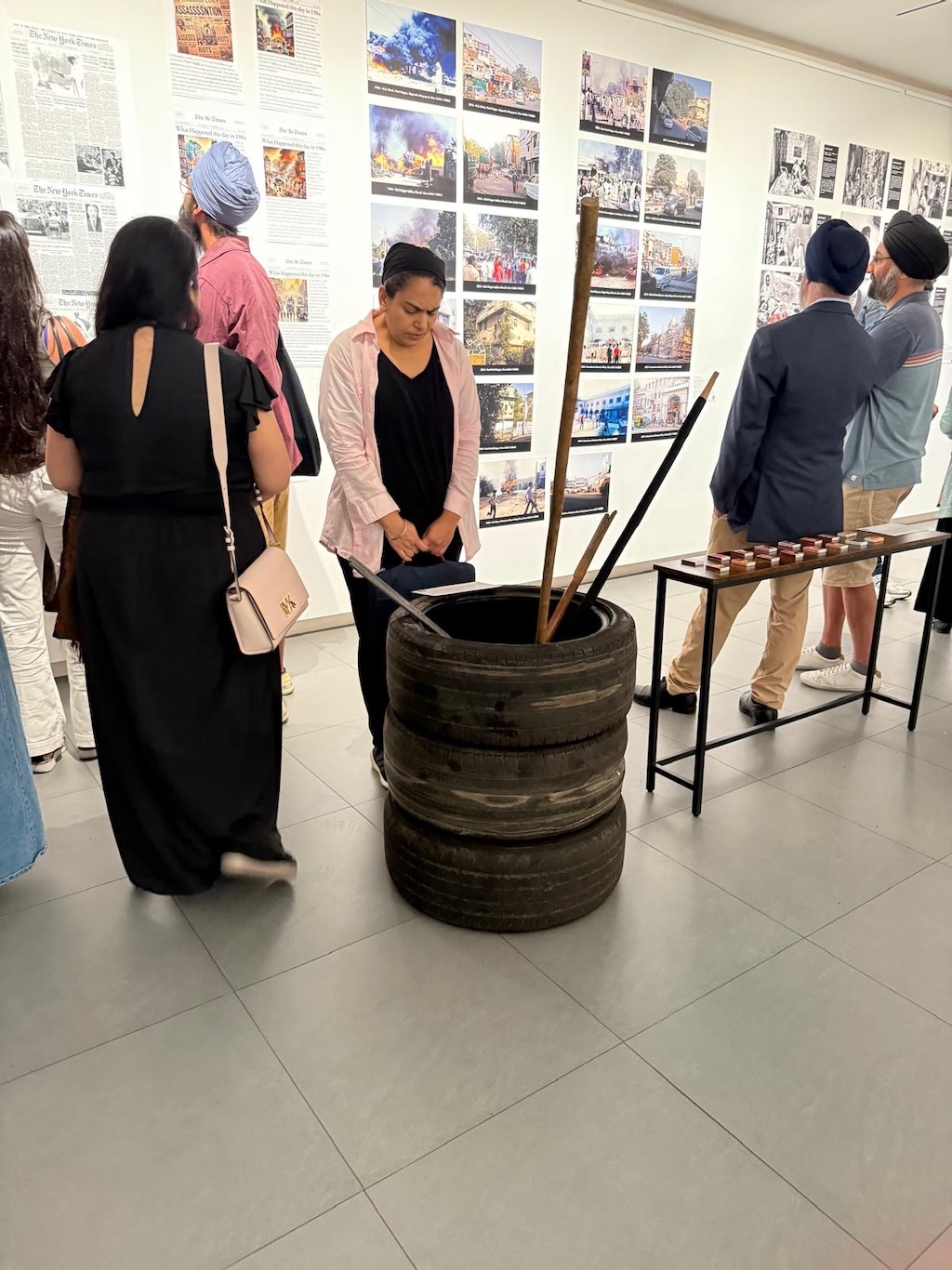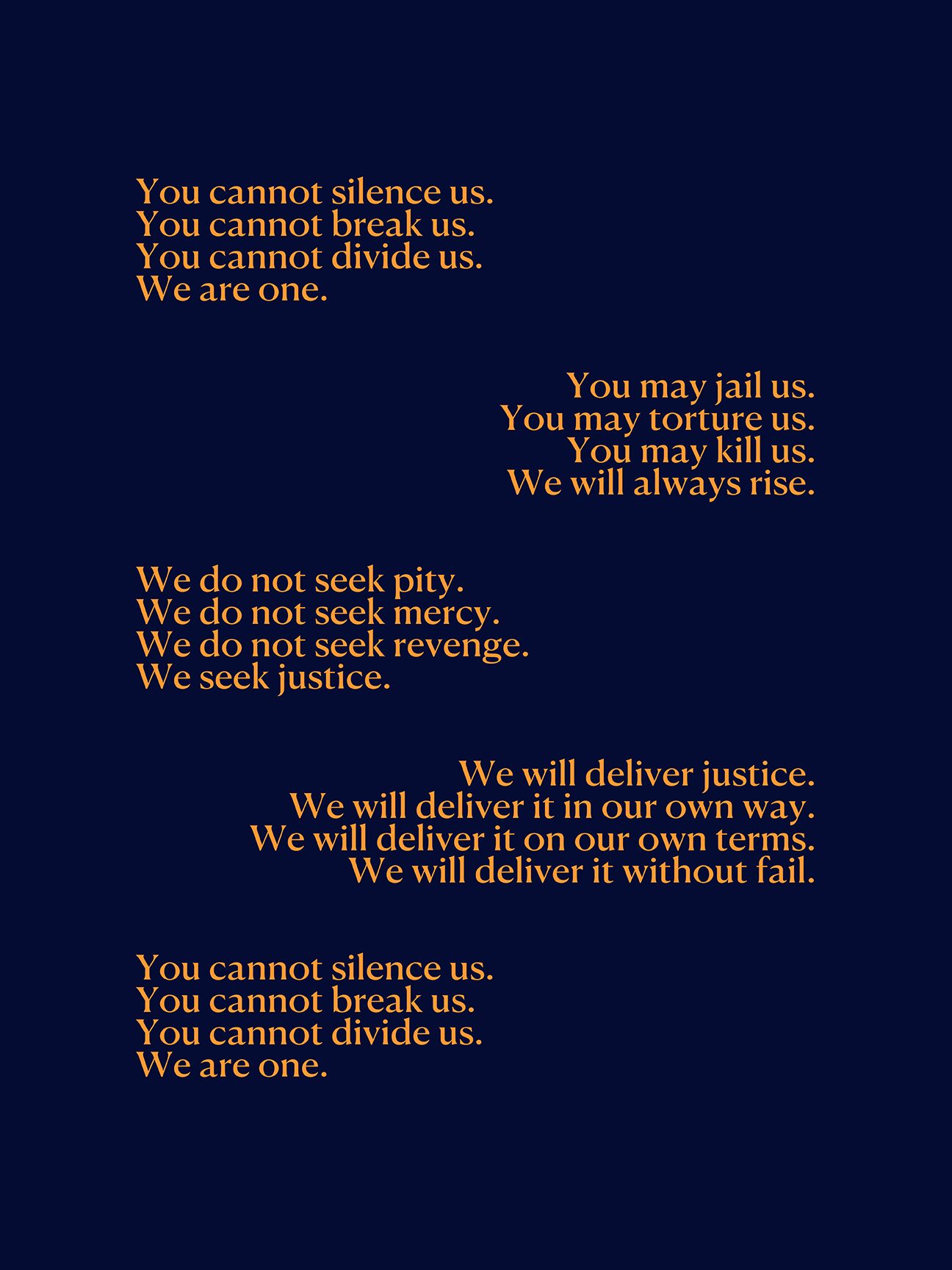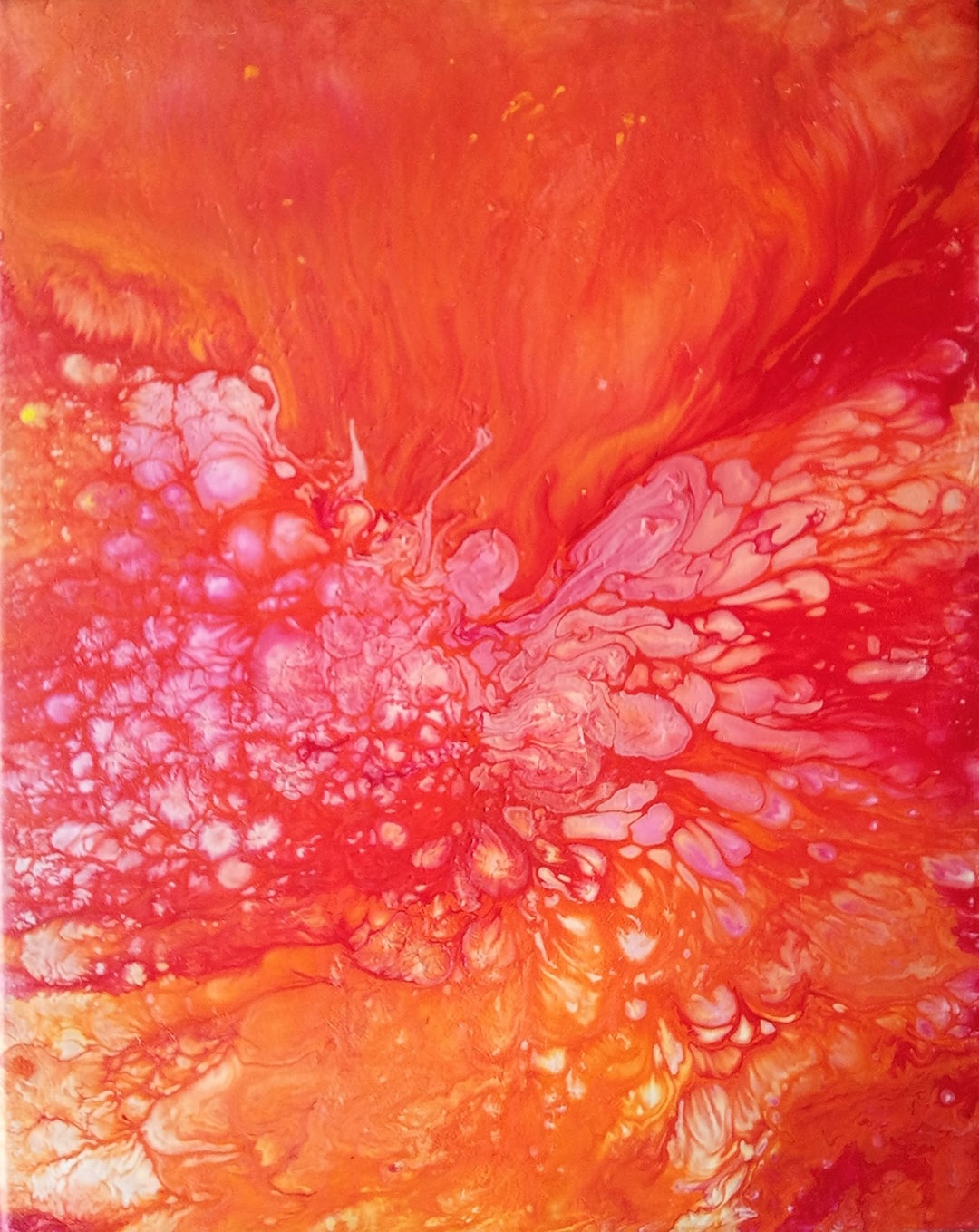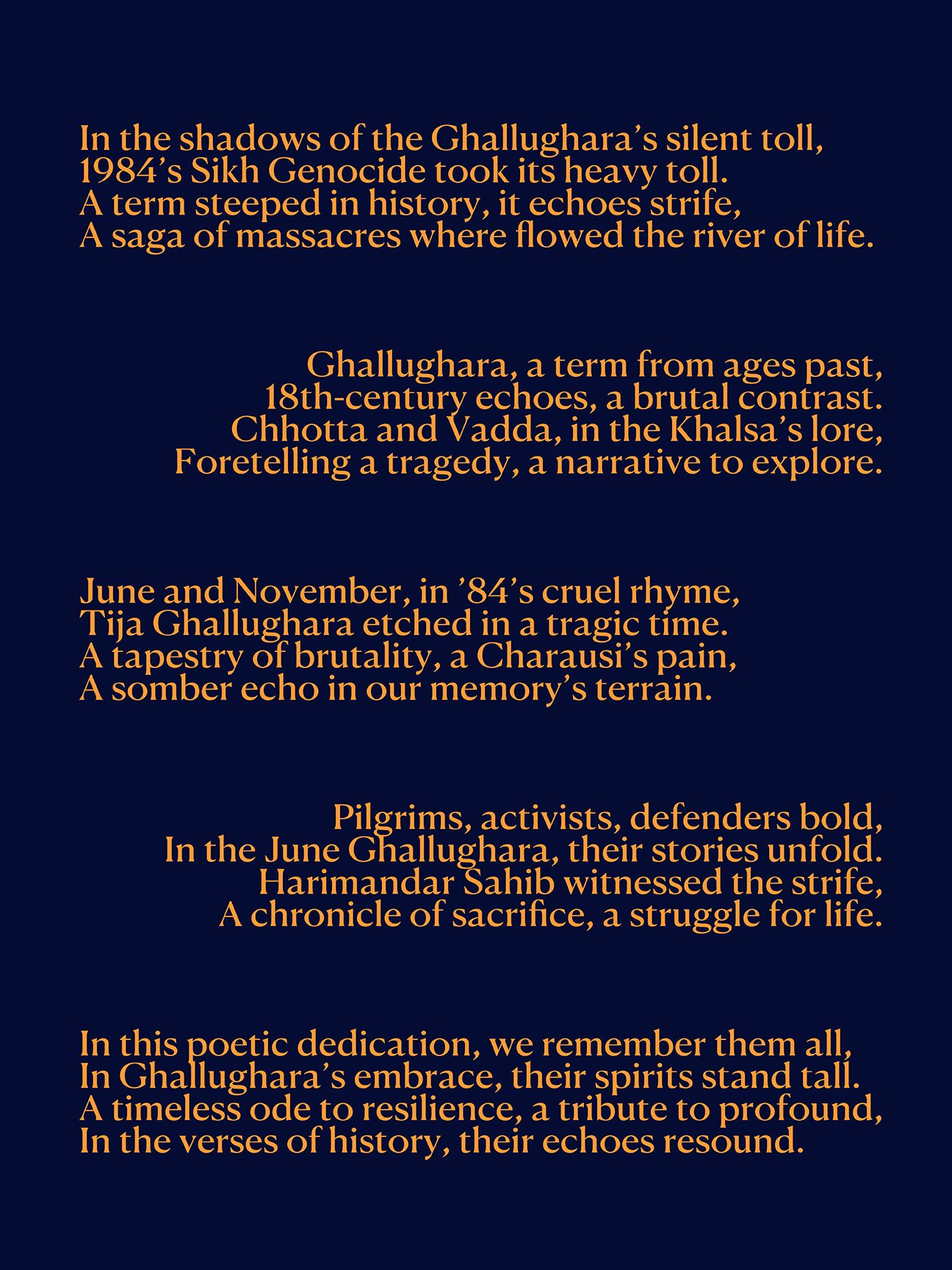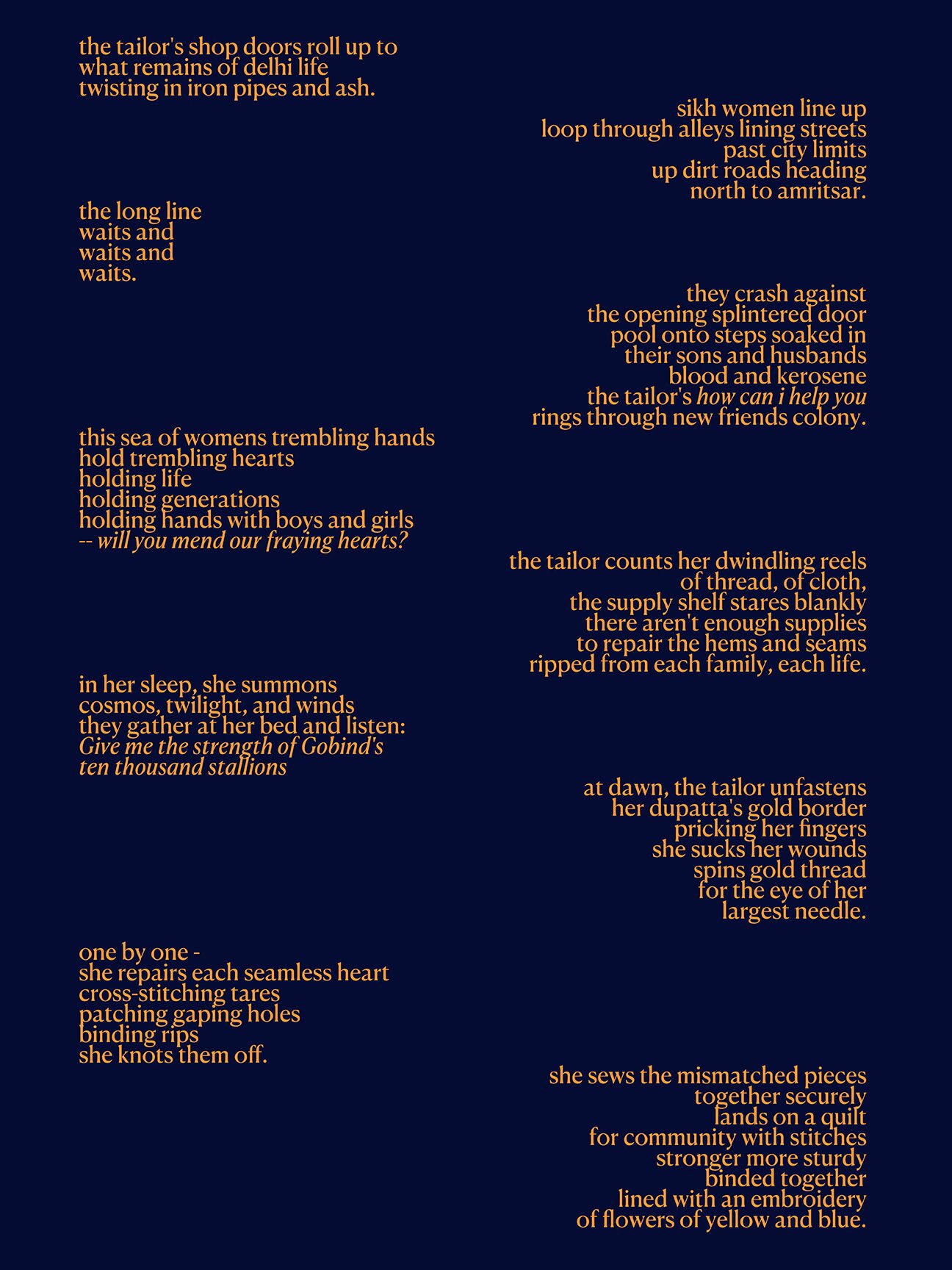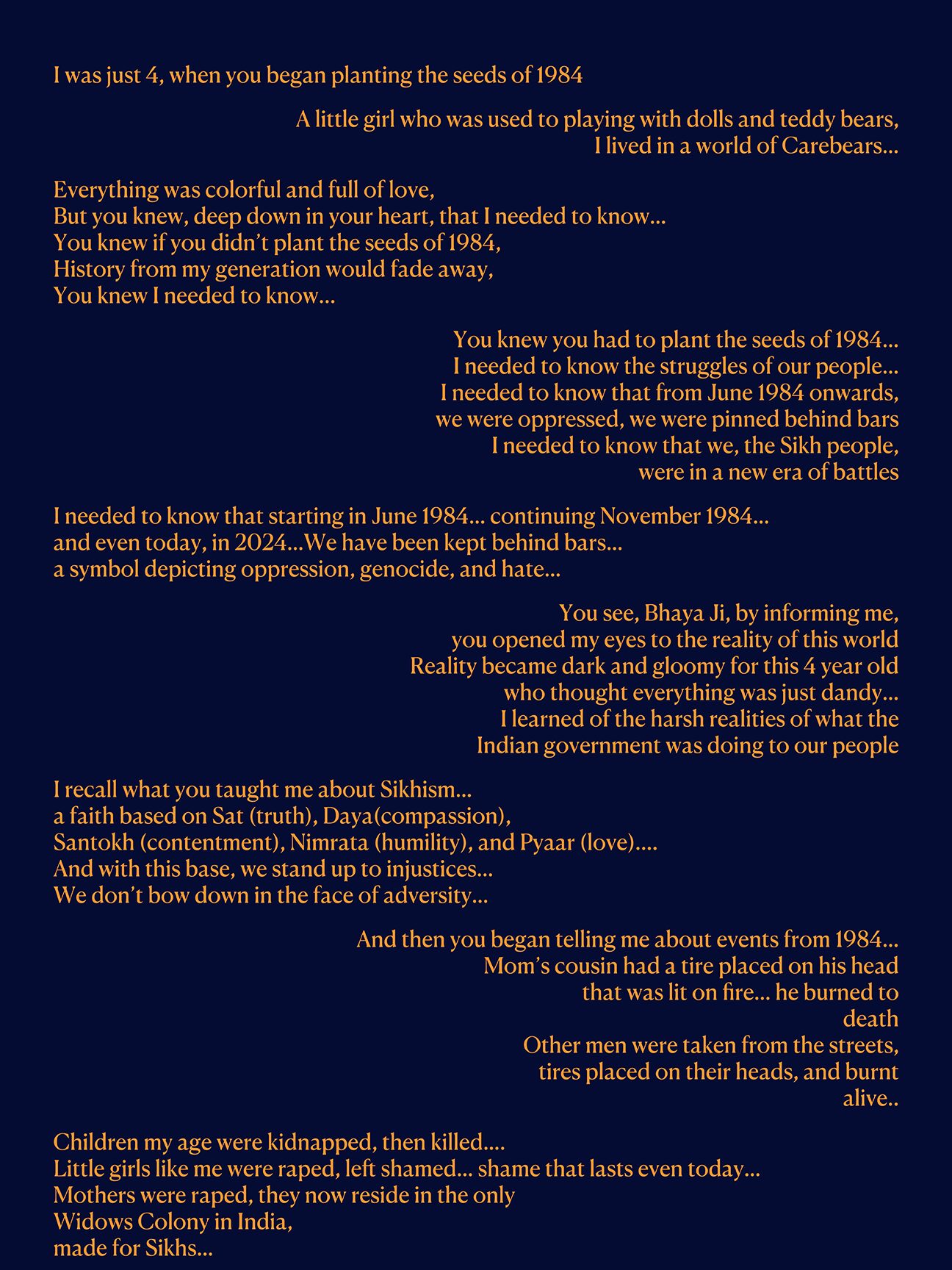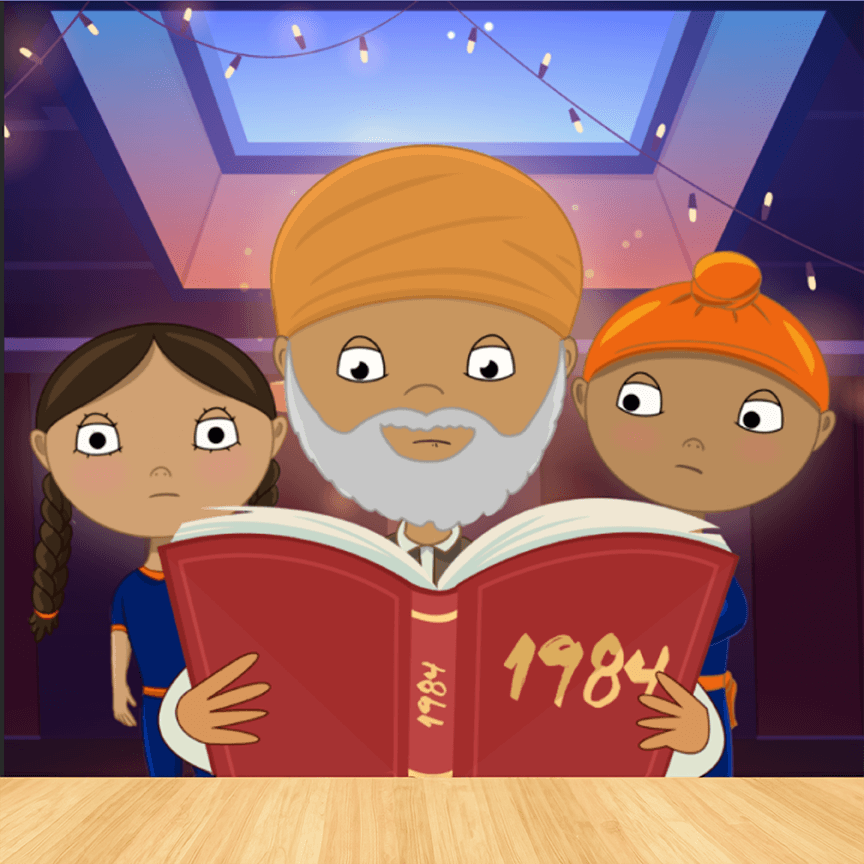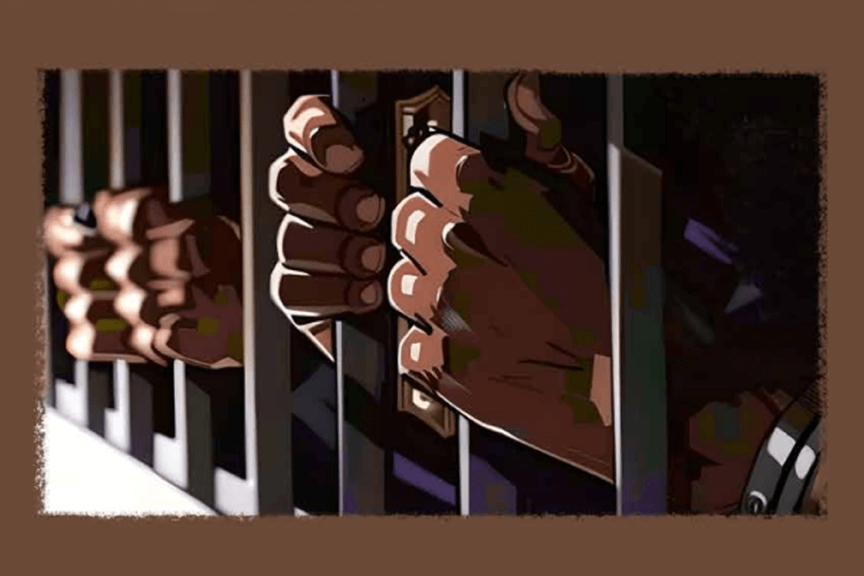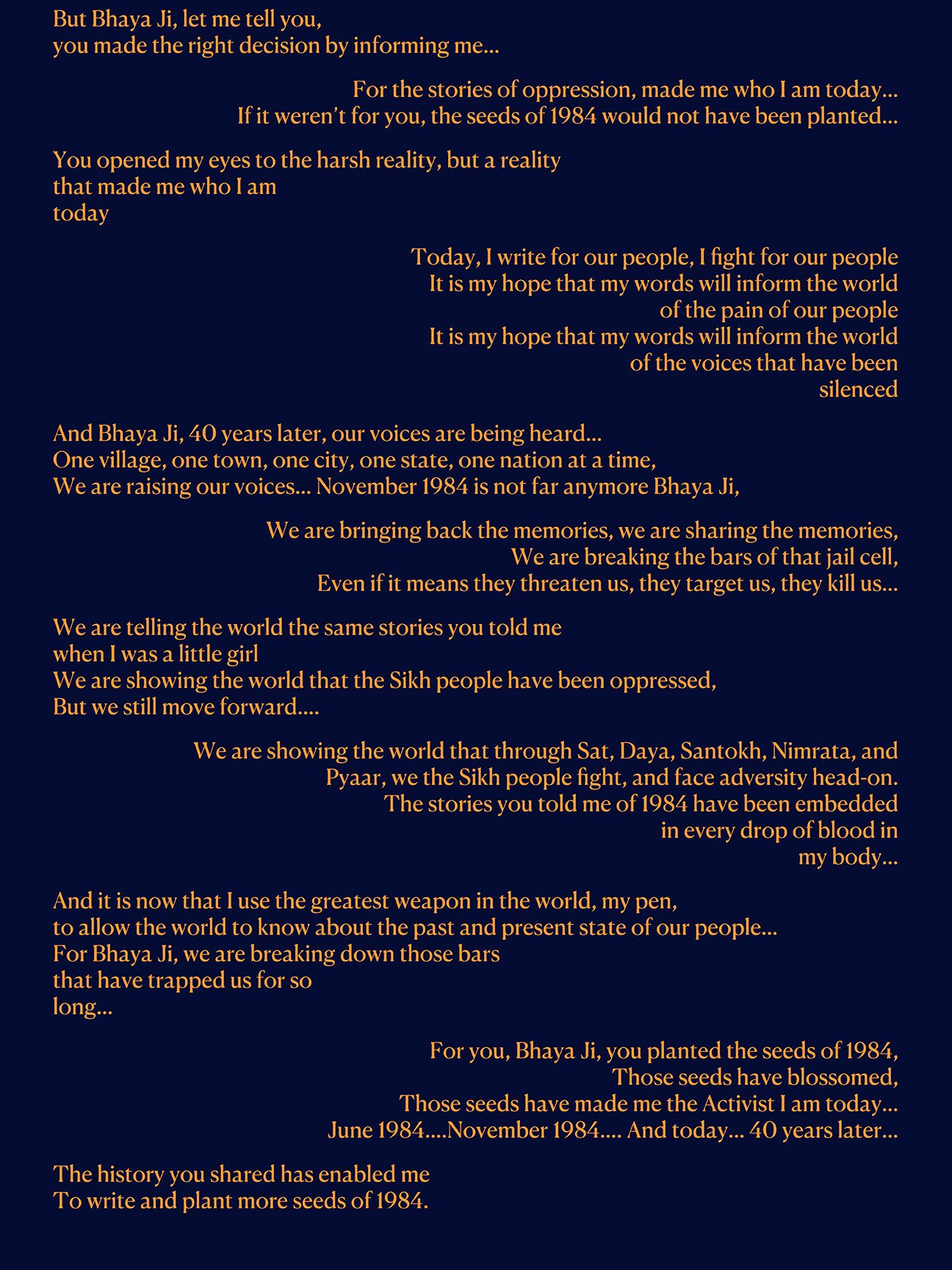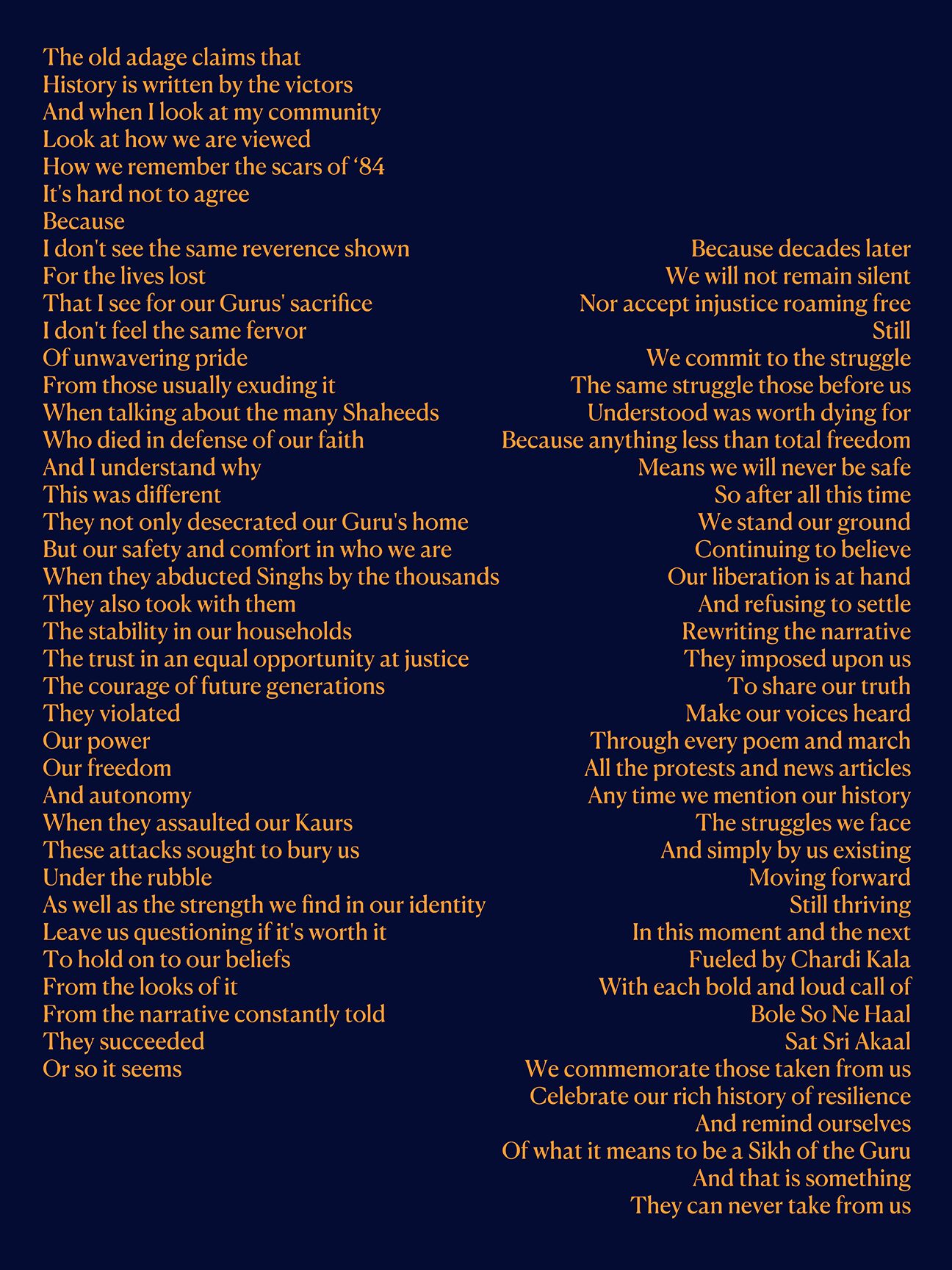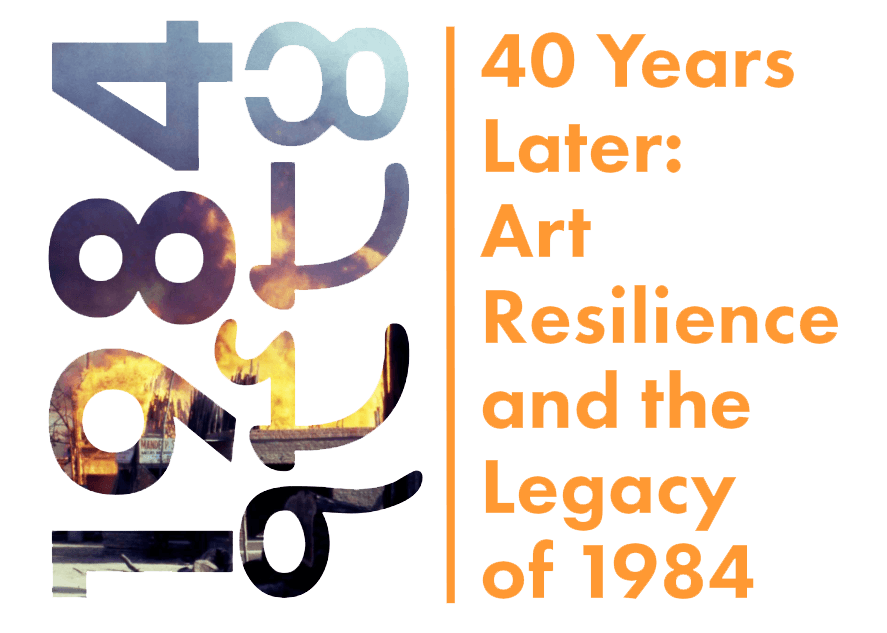
‘Nineteen Eighty Four’ for many in the west brings to mind the fictional dystopian world authored by British Novelist George Orwell.
1984 or ‘Uni Sau Chaurasi’ for Sikhs around the globe is etched as a real life dystopia of genocidal violence in India.
This exhibit creates a space for the voices of those who lived through this carnage, who lost family members, who carry the generational pain and trauma of this genocide.
Through the creative act of 13 artists and activists, this exhibit builds on the foundations of narrative justice, speaking truth to power and highlighting resilience of the human spirit and of the Sikh community.
We invite you to explore and reflect on these artworks through the gallery below, and to act — by sharing this expression with those you are connected with, and to stand up for human rights in whichever way you can.
The Artivists & Their Works
Newspaper Collage – Vishavjit Singh
Killer Sparks – Jaspreet K. Singh & Vishavjit Singh
Weapons of the Mob – Jaspreet K. Singh & Vishavjit Singh
1984: Images Revisited – Sajid Raza Khan
The Continuing Injustice of the 1984 Sikh Massacre – Sanam Sutirath Wazir
Zubani Kahani – Ravjot Mehek Singh
Udasi – Ravjot Mehek Singh
Crimson; Poem: Chronicles of Courage: Woven Sacrifices; Poem: Unyielding Unity: The Sikh Pursuit of Justice – Inni Kaur
Poem: Imaginary 1984 Tailor – Meeta Kaur
Milk, Blood, Salt Water – Navjeet Kaur
Illustration & Poem: Seeds of 1984 – Dr. Simarjeet Kaur
Meeting In Progress – Vishavjit Singh
Uniformed Mobsters – Vishavjit Singh
When A Big Tree Falls – Vishavjit Singh
Poem: Written By – Navpreet Singh
Audio Installation: Untitled – Dalveer Hargobind Kaur
Nirbhau & Nirvair – Vishavjit Singh
Video Montage of Rajiv Gandhi, AP-BBC Coverage, and Poem: Through Darkness, We Rise by Harbani Ahuja
American Sikh – film – Ryan Westra & Vishavjit Singh
The Widow Colony – film – Harpreet Kaur
Visitor Testimonials
Newspaper Collage
Vishavjit Singh
As a young boy I lived through the 1984 carnage with my family escaping a mob’s fury. From day 1, Indian media use the word ‘Riot’ to frame this tragedy and to this day most media outlets, academics and even Sikhs use this word. Today as an artist, writer, activist and storyteller I analyze the power of the media in influencing our perceptions. My current home town newspaper, NY Times covering the 1984 carnage with 6 days of homepage coverage which I got to see recently while preparing for this exhibit. The Artificial Intelligence generated homepages reflect the news coverage by Indian newspapers and other news sources since 1984. 1984 is not just in the past. Its narrative is still being reconstructed and managed. The Sikh community lacking established mainstream news outlets has struggled to lend its authentic voice to this narrative. The last imaginary homepage imagines how a Sikh mainstream newspaper might commemorate this 40th anniversary.
Killer Sparks
Jaspreet K Singh & Vishavjit Singh
Matchsticks provided the spark for kerosene, petrol, and tires to burn and char alive Sikhs across India in November 1984. The faces on these matchboxes highlight the key planners, conspirators and executors at the highest levels of the Indian government, along with the vast police security apparatus that enabled the massacre of Sikhs. The overwhelming majority of these genocidal perpetrators were never tried or even called out for their crimes, and many went on to continue to have successful careers in politics and business while the State protected them from prosecution.
Weapons of the Mob
Jaspreet K Singh & Vishavjit Singh
These were the weapons (tires, iron rods, long bamboo sticks, knives, matches, kerosene & petrol) supplied by politicians to the mobs in Delhi and other cities in India from October 31 through the early days of November 1984 to burn, maim, rape, and kill thousands of innocent Sikhs. Jaspreet (a human rights lawyer and artist) and Vishavjit (a social narrative innovator, artist, and survivor of the 1984 genocide) were inspired to present this sculpture because of the deep impact they had on so many lives and the psyche of the Sikh community at large. The weapons being handed out, in addition to voter lists and school rolls to identify where Sikhs lived and worked, were also part of the clear evidence that the violence was orchestrated, state-sponsored terrorism, rather than “riots” as the violence was referred to for years.
1984: Images Revisited
Sajid Raza Khan
Sajid Raza Khan is a photographer and fitness enthusiast based in New Delhi, India. In 1984 he worked as a Civil Engineer with the Delhi Development Authority (DDA) and was an amateur photographer. As the violence broke out, risking his life he picked up his camera and wandered about the city’s streets shooting grim scenes of carnage. After he retired from his DDA job in January 2015, Khan decided to revisit the sites of arson and killings and take pictures again.
“Those places have changed beyond measure today. They were even unrecognizable to the point that I couldn’t even spot some of them. I wanted to show that difference through my photos,” Sajid Raza Khan said.
“Doing this project over the two months that it took was extremely depressing for me as I had to relive the horror I witnessed all those years ago,” he added. His 1984 photos have been featured in Huffpost, BBC and Buzzfeed.
The Continuing Injustice of the 1984 Sikh Massacre
Sanam Sutirath Wazir
Sanam Sutirath Wazir is a committed advocate for human rights from Jammu and Kashmir, India. He is deeply engaged in documenting historical injustices and large-scale violence through oral history. He has spent more than a decade researching violence of Operation Blue Star in June 1984 and the anti-Sikh pogrom later that year.
His works, including An Era of Injustice for the 1984 Sikh Massacre, The 1984 Sikh Massacre as Witnessed by a 15-year-old and The Continuing Injustice of the 1984 Sikh Massacre are published by Amnesty International, etc. The Kaurs of 1984: The Untold, Unheard Stories of Sikh Women was published this year by HarperCollins India.
The photos in this exhibit are from ‘The Continuing Injustice of the 1984 Sikh Massacre’ Amnesty International report presenting a glimpse into the lives of survivors with the pain and injustice that followed the 1984 massacre. The photos were taken by Shome Basu.
Zubani Kahani
Ravjot Mehek Singh
Zubani Kahani means “the spoken story” in Punjabi. This piece centers my mother when she was 16 years old, living in Delhi during the 1984 Sikh genocide in which countless Sikhs including women and children were tortured and killed by Nationalist mobs. My mother’s memory of that haunting time in her life is impacted by trauma, which only comes forward when triggered. Inspired by her memory and the fact that written history of this relatively recent genocide is unavailable in textbooks or even online due to censoring and oppression from the Hindu Nationalist Government, I chose to piece together my mother’s story through a series of objective interviews of her family members that survived alongside her and play the role of a detective in this great mystery. In an era where oppression, silencing, propaganda, and targeting of Sikhs runs rampant, it is up to us to share our Zubani Kahani.
Udasi
Ravjot Mehek Singh
Udasi means both journey and sadness in Punjabi. To represent my family’s Udasi, this piece features my father’s pagh (turban) with stories of xenophobic encounters I have experienced in post 9/11 America. Attached to the turban is my mother’s “chunni” (decorative headscarf). In this chunni, there are photos depicting my parents’ move to America, creating a collage using the embroidered, traditional fabric. The turban and chunni merge to create a genderless entity, tall and proud like the Punjabi people. The mixture of traditional Sikh femininity and masculinity in this piece proudly displays the religion’s roots in equality of all genders and how Waheguru (God) is a genderless being above the human constructs of gender. The rope represents the incredible struggle of the Sikh people, reminiscent of how Sikh families were slaughtered and hung in the 1984 Sikh genocide, which my mother and her family barely survived. Within these fabrics, archival photographs, and written memories lies our Udasi.
Crimson; Poem: Chronicles of Courage: Woven Sacrifices; Poem: Unyielding Unity: The Sikh Pursuit of Justice
Inni Kaur
“Crimson” captures the haunting imagery of the days in June 1984 when the sky above Sri Harimandar Sahib Complex in Amritsar and the waters below turned fiery red and orange from the devastation and loss. Spirits, depicted in white, rise solemnly towards the skies, representing the souls of those who perished. The vibrant, chaotic hues of red symbolize both violence and profound loss, while the contrasting white figures evoke a sense of transcendence and remembrance.
Chronicles of Courage: Woven Sacrifices A poignant reflection on the 1984 Sikh Genocide, weaving together the sacrifices and stories of those who stood firm amidst brutality. This poem evokes the echoes of past Ghallugharas, paying tribute to the resilience and courage of the Khalsa through generations.
Unyielding Unity: The Sikh Pursuit of Justice This poem powerfully declares the Sikh spirit, speaking to the unbreakable unity and unwavering pursuit of justice. It honors the resilience of a community that rises above oppression and seeks justice on its own terms.
Imaginary 1984 Tailor
Meeta Kaur
As a child who visited India during school summer breaks, I remember the hours l’d spend at the tailor shops lost in the reams of fabric, borders, and fancy buttons. It was a space I occupied as an observer.
Good tailors take their craft seriously, so these fragmented feelings of terror, loss, displacement and grief that I experienced as I learned more about 1984 became the fabrics the imaginary 1984 tailor worked with in the poem.
Milk, Blood, Salt Water
Navjeet Kaur
Photo of performance work on chiffon and silk with embroidered silk threads, 26 x 36 inches each, 2024
As an artist, I have always been drawn to the stories of motherhood and the metaphorical ways it appears in various narratives. As a Sikh woman who became a mother this year, I’ve experienced a shift in my work toward exploring the empowering roles of motherhood in the context of 1984 and Sikh history at large. To me, these stories embody the vision of Sikh resistance and freedom that mothers have envisioned for their communities throughout time as well as the men whose lives were profoundly impacted during the anti-Sikh Genocide in November 1984.
In 2022, I expressed this focus through a ceremonial performance of cutting into a pomegranate which holds a significant memory of love for me. I then printed on chiffon and silk—fabrics commonly used in the ancestral clothing of the women in my family. This choice of materials deepens the connection between my artistic exploration and the rich legacy of Sikh motherhood.
Seeds of 1984
Dr. Simarjeet Kaur
My grandfather, Sardar Maluk Singh Sandhu, or Bhaya Ji, helped me understand the history of the 1984 Sikh genocide. I was just 4 years old when he arrived in the United States. He would sit with me and tell me the atrocities commited by the Indian government. He inspired me to be the activist and author I am today. It was his inspiration that guided to the creation of the Adventures of Simran & Sehaj. Bhaya Ji is one of the characters in all my books. In one picture, you see Bhaya Ji reading about 1984 to his grandchildren, Simran & Sehaj. This picture comes from a recent book I published, Five Days in June 1984. You also see hands tightly gripping jail cells portraying the oppression of the Sikh people in 1984 and even today, 40 years later. In addition to my book series, I am a columnist for the local paper in Frederick, Maryland, The Frederick News-Post. My greatest weapon is my pen, and with the stroke of a pen I hope to set my people free.
Uniformed Mobsters; Meeting in Progress; When a Big Tree Falls; Turbans
Vishavjit Singh
Uniformed Mobsters
I first saw a policeman on the morning of November 1, 1984 in New Delhi from our bedroom window pointing his rifle in the distance. I remember this scene giving me a sense of safety. Hours later this same policeman with his fellow officers was guiding mobs to attack Sikhs and ransack Sikh property. The police force became part of the mobs attacking Sikhs and their belongings across India. None were even brought to justice.
Meeting in Progress
This digital illustration captures what is now well accepted and reported knowledge in India about the direct involvement of the ruling Congress Party leaders in 1984 in planning and executing the killing of thousands of Sikhs across India.
When a Big Tree Falls
This digital illustration captures the most damning statement and evidence of the Indian state’s complicity in the 1984 carnage that consumed the lives of Sikhs across India.
Turbans
Dastaar, as a turban is often referred to in Punjabi, is an article of faith in the Sikh tradition. The turban was historically worn by royalty in South Asia, and the Sikh Gurus adopted this practice to manifest the sovereignty and equality of all people. For a Sikh, wearing a turban reflects a commitment to the values of service, compassion, and honesty. Dastaars have been marked throughout history to target and kill Sikhs including in 1984.
Untitled Audio Installation
Dalveer Hargobind Kaur
Don’t call me resilient. An audio installation in four rotary analogue phones for survivor stories from the 1984 Genocide, followed by a reflection mirror in the present.
As an activist and storyteller, I started my career working in Punjab in 2003 collecting survivor stories of the Sikhs “disappeared” after Operation Blue Star for the Human Rights Commission alongside Human Rights Watch and Amnesty International. As I weaved through the villages in the district of Amritsar, I walked into the homes where either hope was still alive or hope had died a long time ago, but resilience was always strong. For the moments that I was with them, I was their daughter, they cried on my shoulder and they sang songs of resilience. They always said they felt forgotten, but two decades later I still keep a big portion of my Hirda ‘soul’ dedicated to the graceful teachings of survival they taught me as a Human Rights activist.
The audio files with survivors stories are in Punjabi. Visitors to the exhibit are encouraged to send a message to one or more of the survivors. You can click on this link to send us an email with your message.
Nirbhau & Nirvair
Vishavjit Singh
Nirbhau (Fearless) is one of the attributes in the first verse of the spiritual guide of Sikhs, Sri Guru Granth Sahib Jee describing the creator energy permeating the entire universe known to Sikhs as Waheguru. As an act of affirmation, write your name inside the big letters and feel free to take a photo channeling your fearless self.
Nirvair (Without Enmity) is one of the attributes in the first verse of the spiritual guide of Sikhs, Sri Guru Granth Sahib Jee describing the creator energy permeating the entire universe known to Sikhs as Waheguru. As an act of affirmation, write your name inside the big letters and feel free to take a photo channeling your compassionate self.
Through Darkness, We Rise
Harbani Kaur Ahuja
As an attorney and activist, I advocate for Guru Nanak’s social vision of equality and use the law as a tool in the pursuit of Justice. My poem, about the 1984 genocide against Sikhs, seeks to honor the memory of those who suffered and resisted. Through vivid imagery-from the attack on Darbar Sahib to the disappearances of Sikhs-the poem reflects the deep pain, resilience, and unyielding spirit of our community. It concludes with a tribute to human rights activist Jaswant Singh Khalra, whose courageous words exposed the brutality of the genocide, urging us to remember, reflect, and fight for justice.
American Sikh
Vishavjit Singh & Ryan Westra
American Sikh is an award winning and Oscar qualifying short animation film that captures the story of Vishavjit Singh from Washington DC to India and back to the US, as he lives through an identity struggle toggling between assimilation and belonging. Vishavjit has carved a journey of being a cartoonist, writer, performance artist, storyteller, DEI advocate and now a filmmaker.
The Widow Colony
Harpreet Kaur
My film work is fueled by purpose, passion, and a commitment to illuminate pressing issues while amplifying the voices of resilient survivors. The Widow Colony – India’s Unsettled Settlement, serves as a call to honor the memories of the victims of the 1984 state-sponsored Sikh massacre. By focusing on the unwavering strength of the widows, I aim to shed light on this painful past and foster awareness and empathy for those still in pursuit of truth and justice. This film stands as a testament to a dark chapter in history that shall never be forgotten. Through the art of powerful storytelling, I hope to ensure that the voices of these survivors resonate, even 40 years later.
Visitor Testimonials
Amba Singh
“The 1984 exhibit at Jutta Gallery was painful to view. It was close to my heart as the state-sponsored violent attack had directly impacted my family. The phone exhibit where Sikhs spoke about the genocide was powerful, as was the matchbook art of the perpetrators of the violence. The stark reminder of the implements used to attack Sikhs was traumatic to view. The exhibit is important for all to remember and learn how quickly citizens can become disenfranchised, targeted, and murdered to see revenge by the state and its henchmen.”
Jag Gill
“Attending the exhibit was a profound experience that allowed me to connect with our history in a way I never had before. Growing up hearing about the atrocities of 1984, I realized how much of the depth and emotion I had missed until I stood in front of the carefully curated family photographs and listened to the powerful testimonies of survivors. The exhibit masterfully captured the raw pain, unyielding resilience, and the untold stories of that tragic time, honoring the memory of those lost while illuminating the indomitable Sikh spirit of survival and resistance. I left feeling deeply moved, forever changed, and full of admiration for the enduring strength of the Sikh community.”
Haya Srour
“Visiting the 1984 exhibit was a very touching and eye opening experience. Seeing how important every piece of history is, and how strong people had to be to keep pushing after these intense events. I truly appreciated how everyone was willing to guide us, explain anything, and answer all of our questions. The most heart wrenching part was listening to the voices of the most impacted survivors through the telephone art piece but it is necessary to be able to allow their voices to be heard. History cannot keep repeating itself.”
Gurjinder Singh
“I am someone who believes in vicarious trauma and generational trauma. We are a community constantly trying to heal from injustice. I was moved by the exhibit. I could feel the pain of the survivors. I could hear the unbearable loss in their testimonies. I felt closer to my community by being in this space.”
Jasmeen Nijjar
“The multimedia pieces—ranging from poignant illustrations to rare photographs—captured not only the atrocities of that dark chapter in history, but also the enduring strength and resilience of the Sikh community. It’s healing to see how far we’ve come in reclaiming our voices. I was especially moved by the discussions on how the genocide’s legacy continues to impact us today, as well as the ongoing struggle against transnational repression faced by Sikhs worldwide. I am grateful for the opportunity to witness such an important moment in history being commemorated with such respect, creativity, and dignity.”
Shayne Holly
“I was very glad I got to see this exhibit, especially as I was largely unaware of the events. Even though this story is different it’s still the same theme of violence, a different wrapper but contents are still the same.
The various news coverage articles, recorded voices recalling the horrors of the exterminations replayed through the intimacy of an old fashioned telephone receiver, or the matchbox exhibit juxtaposed with torches, kerosene and a stack of rubber tires featuring a who’s who of those in authority who encouraged the violence brings home the terror of events.
Simple everyday items presented in their simplicity in the exhibit used as tools of terror; the mock crime board where red string links the bloody trail of events befalling family members in the form of handwritten notes the exhibit is unflinchingly powerful in portraying individual accounts.
Shayne Holly
A chilling picture of a man posing smiling beatifically in the foreground while black smoke and destruction rages behind him portraying the abject depravity of the violence exacted.
It also brings home the shame that there has never been a reckoning of those involved, never having been held accountable or brought to justice.
That’s the importance of exhibits such as these, to disclose the truth and make these stories known. I would love to see this exhibit continue to grow and travel from city to city, as these stories and the survivors should never be forgotten.”
Jas Ahluwalia
“The 1984 exhibit, while small, was powerful. It evoked so many emotions – sadness, anger, frustration, empowerment. I left fully committed to social justice, and proud to be a Sikh.”
Wendy and Steven Star
“The 1984 exhibition is a powerful and moving portrayal of the anti-Sikh violence. Through a wide mixture of art forms, Vishavjit and his partners blend stunning visuals with meticulous research to expose the scale of the organized attacks on the Sikh community, alongside the misinformation campaign that sought to distort the truth. The exhibition also provides an opportunity for empathy and understanding, offering a platform for victims and their families to share their stories. The artist’s dedication to bringing this history to light is both powerful and necessary. It’s a must-see for anyone seeking to understand the true scale and impact of the 1984 atrocities and their ongoing legacy.”
Vivek Rai
“In times like these, with so much conflict, it is possible to focus on the present and forget the tragedies of the past. Exhibitions like this are a stark and important reminder of what happened in the not so distant past and the deep wounds that continue to reverberate across the hearts and minds of people; it is important to recognize and honor these feelings and show solidarity. I hope that many people get to see this exhibition in the future and learn from it.”
This exhibit was created in partnership by:



With generous support from:


The Artivists & Their Works
Newspaper Collage – Vishavjit Singh
Killer Sparks – Jaspreet K. Singh & Vishavjit Singh
Weapons of the Mob – Jaspreet K. Singh & Vishavjit Singh
1984: Images Revisited – Sajid Raza Khan
The Continuing Injustice of the 1984 Sikh Massacre – Sanam Sutirath Wazir
Zubani Kahani – Ravjot Mehek Singh
Udasi – Ravjot Mehek Singh
Crimson; Poem: Chronicles of Courage: Woven Sacrifices; Poem: Unyielding Unity: The Sikh Pursuit of Justice – Inni Kaur
Poem: Imaginary 1984 Tailor – Meeta Kaur
Milk, Blood, Salt Water – Navjeet Kaur
Illustration & Poem: Seeds of 1984 – Dr. Simarjeet Kaur
Meeting In Progress – Vishavjit Singh
Uniformed Mobsters – Vishavjit Singh
When A Big Tree Falls – Vishavjit Singh
Poem: Written By – Navpreet Singh
Audio Installation: Untitled – Dalveer Hargobind Kaur
Nirbhau & Nirvair – Vishavjit Singh
Video Montage of Rajiv Gandhi, AP-BBC Coverage, and Poem: Through Darkness, We Rise by Harbani Ahuja
American Sikh – film – Ryan Westra & Vishavjit Singh
The Widow Colony – film – Harpreet Kaur
Visitor Testimonials
About ICAAD Artivism


